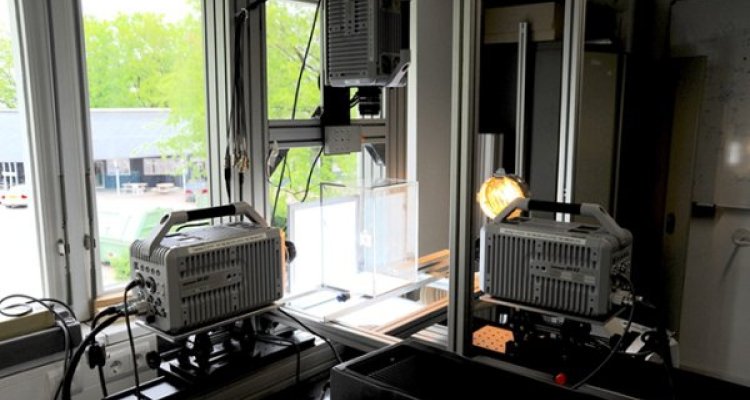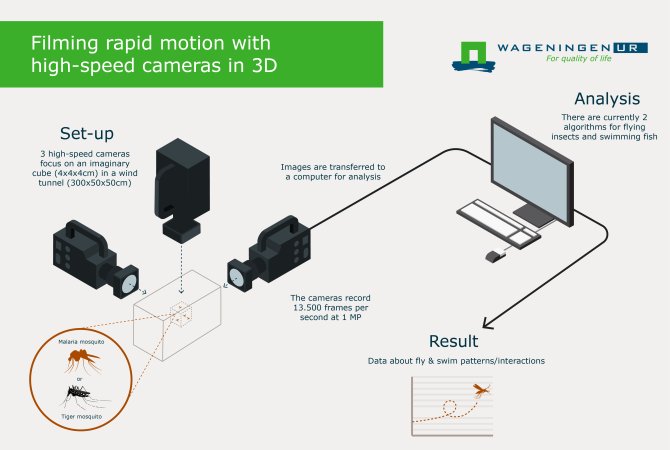
Nieuws
Filming rapid motion with high-speed cameras in 3D
Did you know that Zodiac has a setup with three high-speed cameras that record the flight movements of mosquitoes in 3D? Researchers from Experimental Zoology and Entomology are working together to gain insight into the flight dynamics of mosquitoes with the aim of developing better control methods against malaria. But there is much more to film and investigate with this unique facility.
“With these high-speed cameras you can make extremely fast motions and processes visible which are otherwise impossible to see with the naked eye. This includes applications and biophysics and biomechanics. In fact, you can use these cameras to record all interactions between animals and the laws of physics,” explains Florian Muijres, assistant professor and researcher at Animal Sciences. Thanks to an NWO Veni grant, which Florian received in 2014, and the cooperation of CAT-AgroFood, Wageningen UR researchers and external researchers can use these state-of-the-art high speed cameras.

Black-and-white only
Operator Remco Pieters sums up a few possibilities. “We can use this setup to film and analyse the flight behaviour of mosquitoes, bees, bumblebees and the swimming behaviour of fish. But the camera images can also record processes, such as how mosses disseminate their spores. Or how fractures occur in biscuits. For example, if you acquire more insight into how a biscuit breaks, you can perhaps develop foods within even crisper textures. And something completely different: by filming the distribution pattern of a liquid emerging from spray nozzles, you can work on limiting the spray plumes of pesticides.” According to Pieters, the cameras do have a limitation: they make black-and-white recordings only. For researchers this is often preferable, but a nature photographer who films bloodsucking mosquitoes decided to use a different camera.
Mosquitoes
When filming the (home-grown) mosquitoes, the three high-speed cameras focus on an imaginary cube (4 x 4 x 4 cm) in a wind tunnel (300 x 50 x 50 cm). The flight motions of the mosquitoes are therefore recorded from the front, from the side and from above. Muijres: “Insects make helicopter-like motions. Mosquitoes have even more extreme flight motions than fruit flies. The ‘flapping frequency’ of mosquitoes is higher (500 to 1000 times per second) and the amplitude is lower than with fruit flies. We film and analyse the flight motions of the tiger mosquito and the malaria mosquito. Cameras can do an outstanding job because they are so fast and have a high resolution (1 mega-pixel at 13,500 images per second).”
Data analysis
High-speed video results in enormous numbers of images. Sometimes the images are very interesting in themselves. In the case of the mosquito, the images must still be analysed. For this purpose an automatic tracker was developed that follows the 3-D position of the insect: of the animal and its wings. The 3-D reconstruction not only provides information about the wing beats, but also about interaction between the insect, its wings and the air. Muijres: “With the images we can calculate the forces exerted by the insect. We have currently developed two tracking algorithms: one for flying insects and one for swimming fish. You can also track manually by clicking on separate images, but this is extremely labour-intensive.”
Custom-made set up
The cameras are mobile and can therefore be moved to where they are needed. This is very useful for filming animals in their natural habitats. For example, the cameras will be used in the near future to film bumblebees, which stay rather close to home, in a greenhouse. Pieters: “For every type of research we determine the most suitable setup and the most suitable light sources. This is because you have to optimise the contrast when filming. The cameras use standard lenses, but can also be linked to a microscope.” Pieters helps the researchers to determine the best setup. It is not always necessary to use these particular cameras. Experimental Zoology also has simpler high-speed cameras available.